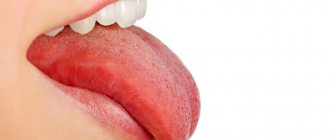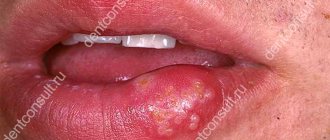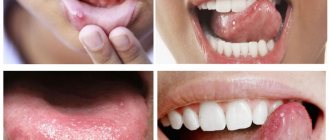Mechanism of occurrence
Growths on the tongue are formed from epithelium, fat cells, muscle fibers, nerves, blood and lymphatic vessels.
The tumor can arise against the background of embryogenesis disorders - the rudiments of foreign tissue structures get onto the tongue. Under favorable conditions, HPV begins to actively multiply and penetrates the basal cells of the epithelium. The DNA of the virus invades the DNA of cells, changes their functions, causes them to actively and chaotically divide and multiply.
Doctor about condylomas in the mouth:
Routes of infection
It is important to know that papilloma is a contagious disease. The virus quickly settles on other people when they come into close contact with an infected person.
To avoid this, you must carefully avoid such routes of infection as:
- Due to sexual contact with an infected partner;
- While kissing;
- When sharing personal hygiene items;
- When receiving injured areas in the oral cavity;
- Transmission of infection from mother to newborn child in the presence of vaginal disease.
The pathogen is transmitted less frequently through domestic contact than through sexual contact, although it can remain viable for a long time in the environment, especially in damp and warm rooms.
Reasons for appearance
Growths on the tongue appear against the background of dental diseases, dysfunction of internal organs, or due to non-compliance with hygiene rules. One of the main causes is the human papillomavirus (HPV). When it is activated, papillomas are formed. The risk group includes people with autoimmune pathologies and immunodeficiency conditions, people who are promiscuous.
Provoking factors:
- taking certain corticosteroids;
- stomatitis, glossitis, periodontitis, systematic injuries of the tongue and oral mucosa;
- indulging in hot or spicy foods leads to burns on the mucous membrane, which are poorly treated in a constantly humid environment;
- candidiasis, herpes;
- intestinal infections, helminthic infestations, metabolic disorders;
- frequent stress;
- smoking, alcohol abuse, working in hazardous industries;
- avitaminosis;
- changes in hormonal levels during pregnancy, menopause, and puberty;
- In children, papillomas appear due to the habit of putting dirty hands and objects into their mouths;
- contact with a sick person or carrier of infection.
In older people, growths on the tongue occur due to age-related changes in the body and improper care of dentures.
Congenital growths in children appear due to poor heredity, intrauterine development disorders, viral diseases of the mother during pregnancy, and birth injuries.
Doctors about HPV:
Methods of infection
The human papillomavirus is transmitted from person to person in different ways.
How people become infected with HPV:
- during sexual intercourse;
- in public places by domestic means - toilets, gyms, baths;
- self-infection – when papilloma is injured;
- intrauterine infection from mother to child.
For a long time, the infection does not manifest itself in any way; the virus begins to actively multiply against the background of weakened immunity.
Important! Barrier contraceptives do not protect 100% from human papillomavirus infection.
Causes of tongue cancer
The symptoms of tongue cancer cannot be confused with anything!
Tongue cancer, like any other form of malignant tumor, appears for a reason. Its appearance is preceded by many factors that provoke cell mutation. The main causes of tongue cancer include:
- Excessive smoking. But in some cases, even smokers with little experience may develop a tumor. This is due to the individual characteristics of the body and the structure of the mucous membrane
- Chewing nicotine gum, which is used by people if they want to get rid of a bad habit.
- Chewing tobacco, which irritates and damages the mucous membranes
- Excessive consumption of alcoholic beverages
- Heredity. Many people know that if someone in their family had one or another cancer disease, then their descendants are at risk
- Serious diseases that can provoke a decrease in the body’s defenses, that is, immunity
- Papilloma virus. Scientists attribute an increase in the number of cases of patients with tongue cancer to this reason. This is because people are engaging in oral sex more often. And, as you know, papilloma is transmitted both sexually and oral
- Inflammation of the gums that remains untreated for a long period of time
- Poor dental condition
Despite the fact that almost everyone knows about the main causes of tongue cancer, few people pay attention to them. And therefore, every year the number of people with this disease, which is not so easy to treat, is growing.
Kinds
There are 2 types of growths :
- Reactive - appear due to constant mechanical damage to the tongue, burns.
- Neoplastic – a consequence of disorders in the body. Most often, many such neoplasms appear in various parts of the oral cavity.
By shape
Growths on the tongue can have different shapes :
- Most often, neoplasms have clear boundaries and are colored white, pink, or red.
- The pointed formations are pink, have a stalk, cause significant discomfort, are often injured, grow quickly and occupy large areas of the mucosa.
- Flat growths have a rounded shape and resemble plaques in appearance. They grow slowly, are damaged less often, and practically do not bother.
- With stomatitis, reactions to medications, microtraumas, the growths look like pimples and blisters.
By location on the tongue
Growths can appear on any part of the tongue mucosa. The main places of localization are the tip, lateral surfaces, and root. Most often they occur on the side; less often, tumors form on the hard palate and lower surface.
Papilloma on the tongue of an adult
Papillomas can be localized in various areas; they often cause significant discomfort to a person, even if they are subtle.
The main inconveniences are as follows:
- Changes in speech, as the articulation of the pronunciation of individual sounds changes.
- Risk of damage during consumption.
- Psychological discomfort if a person fears that the tumor will be noticed during a conversation or kiss.
The virus that causes the formation of papillomas can enter the human body in the following ways:
- Oral sex with virus carriers.
- The presence of direct contact of open wounds or mucous membranes with infected blood, semen or saliva.
- Transmission from mother during childbirth.
More uncomfortable growths on the body are papillomas on the butt, which are formed due to many factors.
What could it be
The most common types of growths on the tongue are lipomas, fibroids, papillomas, hemangiomas, and polyps.
| Type of growth | What does it look like |
| Papillomas | Flat - noticeably rise above the epithelium, wide, light in color. They are formed one at a time. Pointed (condylomas) are light-colored neoplasms in the form of papillae with a sharp end. They often merge into groups, grow, and increase in size. Externally similar to the comb or inflorescences of cauliflower. Thread-like - thin, protruding noticeably above the surface of the epithelium, colored bright red. Form groups. |
| Polyps | The neoplasm is flat or convex in shape in the form of a lump, formed from ectopic gastric mucosa. Most often it appears on the root of the tongue. |
| Adenomas | Formed from the glands of the mucous membrane of the tongue, it looks like a small ball. Localized on the tip and root of the tongue. |
| Lipomas | Consist of fat cells. They have a soft, lobed structure, located on the root of the tongue or under it. They grow slowly and do not hurt. Flap lipoma is flat. Can grow deep into tissues. Vulgar - a small bulge on the tongue. |
| Fibroids | Consist of connective tissue. Elastic, painless neoplasms are round in shape and sometimes have a stalk. They do not differ in color from the mucous membrane, sometimes they have a pale yellow or white tint. Neurofibroma contains nerve fibers and is therefore painful. It forms on the root of the tongue and does not differ in appearance from a regular fibroma. |
| Myomas | Growths on the surface of the tongue with a dense structure, up to 1 cm in size, are covered with a mucous membrane. Formed during the proliferation of muscle cells. |
| Hemangiomas | Vascular neoplasms look like red or blue spots. Sometimes they bleed. |
| Cysts | A retention cyst consists of muscle fibers and forms on the inner surface, the frenulum of the tip of the tongue. This is a small ball with liquid inside. |
| Botriomycomoma | The tumor is flat or spherical, reaches 10 cm in size, sometimes consists of several lobules. The shade varies from red to burgundy, the surface is smooth or covered with crusts. |
| Lymphangioma | Congenital benign neoplasm. Grows from the walls of lymphatic vessels. The surface is covered with bubbles, growths are located on the upper surface and tip of the tongue. They often become inflamed and are often accompanied by problems with bite and speech. |
| Struma | It is rare and consists of thyroid tissue cells. This is a small node up to 3 cm in size, formed at the root of the tongue. |
| Sialadenitis | The tumor appears against the background of inflammation of the saliva and sublingual gland. Causes: infectious pathologies, tuberculosis, mumps, syphilis. |
Clinical case – condylomas on the tongue:
Growths on the tongue in adults and children
Neoplasms in children and adults are equally common. In adults, these are mainly papillomas, adenomas, cysts, and lipomas.
In a child, papillomas are presented in the form of epithelial hyperplasia - the tissues of the tongue mucosa grow greatly. The active growth of HPV most often begins after influenza, sore throat, or a viral disease. Lymphangioma is diagnosed mainly in children under one year of age. Hemangiomas often occur in girls.
What does papilloma look like on the tongue?
Sometimes people mistakenly mistake the features of the anatomical structure of their tongue for new growths. For this reason, only a specialist can make a final diagnosis.
Papillomas most often have the following appearance:
- A small tumor, the maximum size of which can reach 1.5-2 cm. However, in most cases, papillomas appear on the tongue, the size of which does not exceed 0.5 cm.
- The surface virtually always has a bumpy structure.
- Sometimes papilloma is a growth that looks similar to a small papilla.
- The color almost always matches the color of the surrounding mucous membrane, but the largest papillomas may have a lighter shade.
Photo
Below is a photo of papillomas, allowing you to understand what they look like:
Papillomas can appear in many parts of the body. Look at the photo of papilloma on the neck.
Symptoms
When any growth forms on the tongue, pain and discomfort in the mouth occurs.
Problems with chewing food, speaking, and swallowing are often observed. Sometimes swelling and redness of the tissue occurs, and one or more papillae become enlarged. But all pronounced symptoms are absent in the initial stages; they appear when the tumor is of a significant size. Sialadenitis is manifested by general weakness, fever, pain and burning, swelling of the affected area, and an unpleasant taste appears in the mouth.
If the structure or color of the growth changes, it begins to grow rapidly - this may be a sign that the growth has degenerated into a malignant tumor.
Reference! In children, papillomas on the tongue occupy large areas, often the neoplasms are covered with a white coating.
Diagnostic methods
Knowing which doctor to contact, the patient is recommended to undergo diagnostics in order to avoid complications of the pathology. Polyp growths on the front of the tongue are immediately visible; they interfere with eating and speaking, bleed, and are easy to injure. If there are growths on the lower part of the tongue, the doctor detects it during a visual examination when he asks the person to show his tongue.
A doctor, having noticed a neoplasm, which can also be localized on the root, studies its structure, that is, establishes the type of pathology. The structure of papilloma on the tongue is fine-grained and rough.
In children, the formations occupy large areas; they can be covered with a white coating, so identifying the disease in childhood is much easier. Having seen such manifestations, the doctor usually determines immediately that it may be papilloma.
Elderly people often experience an oncological tumor that may resemble papilloma. The only difference between a cancerous tumor is its strong compaction.
PCR
Then the doctor can send for PCR to determine the type of pathogen, perform a biopsy, after which the biopsy is sent for histological examination.
The doctor also differentiates papilloma on the tongue from diseases such as cancer, cyst, ulcer (callus) formed due to stomatitis. After passing the examination, the patient is prescribed appropriate treatment.
Diagnostics
The dentist diagnoses and treats growths on the tongue.
Sometimes additional consultation with a dermatologist, endocrinologist, virologist, immunologist and otolaryngologist may be required. Examination and diagnostic methods:
- Anamnesis collection, examination of the oral cavity and skin. The doctor notes the color, shape and consistency of the growth on the tongue, its surface, and location.
- A general blood test shows the presence and intensity of inflammatory processes in the body.
- Tissue biopsy - biomaterial is sent for histological examination.
- PCR diagnostics – identifying the type of causative agent of the pathological process.
- Analysis for thyroid hormones.
- Digen test.
The methods allow us to identify the characteristics of the disease with high accuracy. But at the initial stage of HPV development, there are often false positive and false negative results.
Removal
The method by which the papilloma will be removed must be chosen by the treating specialist. It depends on the location and characteristics of the body. There are the following ways to eliminate tumors:
- Surgical excision using a surgical scalpel. After the procedure, “cauterization” is performed. A similar technique is used in the presence of single growths or when they are inaccessible and it is impossible to use other methods.
- Laser elimination. The most effective, painless method with no adverse effects. The disadvantage is the high cost of the procedure.
- Electrocoagulation. The method involves cauterizing the growth with an electric current. The disadvantages include painful manipulation and a long rehabilitation period.
- Radio wave surgery. The technique is similar to the previous one, only instead of current, high-frequency radio waves act on the papilloma. The pain is insignificant, the number of adverse effects is minimal and the rehabilitation period is short.
- Cryodestruction. The most unpopular surgical method for eliminating papilloma on the tongue. The tumor is removed by influencing it with cold. The wart is frozen to liquid nitrogen temperature. The growth will be frozen and die within a week.
If the technique involves excision of the wart, then the biomaterial is sent for histological diagnosis in order to analyze the structure of the growth.
Can growths be malignant?
At any moment, the growth can degenerate into a malignant tumor. Causes: constant damage to the tumor when talking or chewing food. Tongue cancer is classified as squamous cell; other forms, such as basal cell carcinoma or carcinoma, are rarely diagnosed.
Types of malignant tumors:
- An ulcer is a dense neoplasm that turns into an ulcer; it often hurts and bleeds. Located on the lower surface of the tongue.
- Infiltrative - a seal on the tip or back surface of the tongue, covered with a white coating. Constantly and severely painful.
- Papillary - a solid tumor on a stalk, formed on the lateral surfaces. Characterized by slow growth.
The prevalence of tongue cancer is 5 cases per 100 thousand population . The disease is easy to diagnose. But people often do not notice or ignore the symptoms of the pathology and go to the doctor with already advanced forms of the disease.
Formation of tongue cancer
Stages and symptoms of tongue cancer:
- Initial . Whitish spots appear on the tongue, most often on the lateral surfaces. These are papillary growths that look very similar to plaque. During examination, doctors often mistake formations for manifestations of glossitis and stomatitis. There is no pain or discomfort.
- Stage of clinical manifestations . The spots gradually become denser and transform into a tumor. Pain appears, which often radiates to the neck, ears, and temporal region; the tongue, neck, and face swell. When the formation becomes infected and suppurates, unpleasant odor from the mouth is disturbing. Problems arise with swallowing, articulation, and some areas of the tongue become numb. Metastases often spread to the cervical and submandibular lymph nodes.
- Launched . Necrosis and tissue decay begins, the tumor penetrates deep into the tongue.
- Terminal . Metastases extend beyond the oral cavity - lungs, liver, bones. Treatment at this stage is ineffective, and the prognosis is disappointing.
Specific diagnosis involves examining a smear of the fingerprint to identify cancer cells. A biopsy of the tumor is required. Additional research methods - ultrasound of the tongue, lower jaw and neck, x-ray or CT scan of the skull are prescribed to identify metastases.
Video about tongue cancer:
Treatment methods:
- Surgical . To radically remove a malignant tumor, partial resection or complete removal of the tongue is performed. When the tumor grows into the surrounding tissue, complete resection is performed, down to the bones of the lower jaw.
- Radiation therapy . The tumor is irradiated with X-rays. Radiotherapy is carried out before and after surgery.
- Polychemotherapy . A method of treating advanced forms of the disease, used in the presence of distant metastases. Drugs – Cisplatin, Methotrexate.
Surgery
Radio rays
Polychemotherapy
Attention! One of the main differences between malignant and benign neoplasms is that cancerous tumors are very dense. They rise somewhat above the mucous membrane and have an uneven surface.
Treatment of the disease
The success of the chosen treatment depends on the stage at which tongue cancer was detected. Based on this, as well as on the individual characteristics of the person, treatment will be selected that will help reduce the tumor or get rid of it altogether. After the results of tests and all examinations have been received, and the alleged diagnosis has been confirmed, the patient will immediately be sent to an oncologist, who will begin treatment. Typically, three methods are used:
- Surgical intervention. Depending on the size of the tumor, one or another method of surgical intervention will be chosen:
- If there are many lesions or the tumor is very large, the person may undergo a glossectomy, that is, removal of the entire tongue or most of it.
- In the event that it is possible not to remove everything completely, then partial resection is performed, and in some cases the person retains the ability to speak.
- If the tumor has already affected other tissues, then those areas in which cancer cells are present can be removed. Sometimes partial resection of the tissues of the floor of the mouth or jaw may be necessary, as well as removal of the affected lymph nodes
- Chemotherapy. Chemotherapy is the introduction of special drugs into the human body, the action of which is aimed at destroying cancer cells. Most often, chemotherapy is prescribed in cases where it is necessary to reduce the tumor to an operable size, as well as in the presence of metastases to other organs. Today, polychemotherapy has become especially popular, the effectiveness of which ranges from 50 to 70 percent (if we talk about standard monochemotherapy, its effectiveness is no more than 30 percent). A combination of drugs such as fluorouracil and platinum-based drugs is used here. Thanks to the unusual combination, the highest effect is achieved. And in the simplest cases, only one or two sessions of such chemotherapy are required. Chemotherapy is also given after surgery to kill remaining cells and reduce the risk of relapse.
- Radiation therapy. It is used both as an independent treatment and as a combined treatment. For the first procedure, average values are selected, that is, when the total focal dose reaches 35 or 40. If after the first session there is no noticeable improvement or there is, but insignificant, then radiation therapy is completed and another treatment method is chosen. If at this dose the tumor has decreased by 50 percent, then radiation therapy is continued until there is significant improvement, and the total focal dose is increased to 60.
Under no circumstances should you ignore the advice and recommendations of an oncologist and try to treat cancer yourself. Many people believe that traditional medicine will help them. Unfortunately, in this case it is powerless, since it cannot have the effect on cancer cells that is required. In addition, treatment with folk remedies is not aggressive. And this is how you need to approach cancer.
Treatment methods
Drug therapy is carried out at the initial stage of the formation of papillomas in the mouth. All other growths are removed surgically. Folk remedies will help strengthen the body's defenses, prevent the growth of formations and the development of complications.
Until complete removal of growths from the diet, you need to exclude hard, sour, spicy, salty, hot and cold foods.
Medicines
The choice of medications depends on the type of growth, the cause of its appearance, the general condition and age of the patient.
How to treat growths:
Antiviral ointments and tablets - Acyclovir, Panavir, Altabor. Prescribed for papillomas to suppress HPV activity.
Acyclovir
Panavir
Altabor
Solutions for injections – Ferrovir, Immunomax, Cycloferon. More effective against HPV than pills.
Ferrovir
Immunomax
Cycloferon
Rectal suppositories with antiviral and immunostimulating effects - Galavit, Kipferon, Genferon.
Galavit
Kipferon
Genferon
Immunomodulators – Likopid, Neovir.
Lycopid
Neovir
Local antiseptics – Chlorhexidine, Chlorophyllipt. Eliminate inflammation, bleeding, prevent the spread of infection.
Chlorophyllipt
Vitamin A oil solution – prevents tumor growth. Treat the growth daily.
Vitamin A
Vitamin complexes – Supradin, Complivit, Ascorutin.
Supradin
Complivit
Askorutin
If growths are detected during pregnancy, immunostimulating drugs - Viferon, Reaferon. Safe immunomodulators for children - Amiksin, Viferon.
Viferon Reaferon Amiksin
Folk remedies
Non-traditional methods will not help cope with growths on the tongue.
But folk remedies have anti-inflammatory, antiseptic effects and help strengthen the immune system. They can be used to enhance the therapeutic effect of drugs. When removing growths surgically, folk remedies are not used.
Recipes:
- Pour 500 ml of boiling water over 20 g of dry plantain leaves and leave in a sealed container for 15 minutes. Drink the strained infusion 100 ml twice a day. The duration of treatment is 10 days. The product increases the body's resistance to viruses.
- Grind the peeled pink potatoes and squeeze the juice through cheesecloth. Drink 100 ml before breakfast. Duration of treatment – 3 weeks. The drink has a pronounced immunostimulating effect.
- Pour 500 ml boiling water 1 tbsp. l. dry chamomile or calendula inflorescences, leave for an hour. Use the strained infusion to rinse your mouth twice a day for 10 days. This remedy is a natural antiseptic and accelerates the healing process of damaged tissue.
- Mix 4 parts hemp oil with 1 part honey. Treat the growths with the mixture 5 times a day.
- Lubricate the new growths 2-3 times a day with fresh juice of sour apples.
- Treat the growths with raw chicken protein. Apply every 15 minutes for an hour. Do the procedure three times a day. The duration of treatment is 10 days.
- Mix 100 g of chopped beets, 200 g of carrots. Add 1 lemon, twisted in a meat grinder along with the peel, 30 ml of olive oil, 100 g of walnuts. There are 1-2 tbsp. l. in a day. This vitamin complex strengthens the immune system.
Important! It is often recommended to use fresh celandine juice to treat growths on the tongue. This method is dangerous, the plant is poisonous, you can get poisoned. If the juice gets on healthy tissue, it will cause a severe burn. Papillomas in the mouth cannot be cauterized with hydrogen peroxide, vinegar, or removed with thread.
Removing growths
There are several methods for removing growths on the tongue. The choice depends on the location of the neoplasm and the presence of contraindications in the person.
Methods for removing growths:
| Surgically | Excision of the tumor with a scalpel under local anesthesia. The wound is disinfected, sutured, and the stitches are removed after a few days. The method is affordable, but causes a lot of discomfort during and after the operation. Contraindications: pregnancy and lactation, exacerbation of herpes, acute infectious and inflammatory processes in the body. |
| Laser | The most popular method of removing growths. The tumor is removed quickly and without pain - the procedure lasts no more than 20 minutes. There is no infection in the wounds, relapses are rarely diagnosed, and the rehabilitation process is short. Laser therapy can be used to remove tumors in children over 2 years of age. Contraindications – tumor size more than 3 cm, diabetes mellitus, pregnancy and breastfeeding, diseases of the circulatory system. Disadvantages: high cost, inability to send tumor tissue for histology. |
| Cryodestruction | Before the procedure, it is necessary to cure all infectious diseases. The affected area is exposed to liquid nitrogen, which stops the growth of the growth. During the session, the risk of infection and bleeding is reduced to zero. The duration of the procedure is 30 seconds. Cryodestruction is safe for children over 1 year of age. But this method is painful, often scars form at the site of exposure to cold, and it is difficult to control the depth of freezing. The method is not used to remove multiple tumors. After the session, immunity sharply decreases, so after removing the growth you should immediately start taking immunostimulating drugs. Contraindications – epilepsy, convulsions, arterial hypertension, vasospasm, pregnancy and lactation. Cryodestruction is not suitable for removing growths on the uvula and sublingual frenulum. |
| Electrocoagulation | A special loop is placed on the growth, which transmits electric current deep into the tissue. The tumor is cut off, and the vessels are sealed at the same time, which prevents bleeding. The method is painful, recovery takes a long time. But scars do not form, relapses are rare, and several tumors can be removed at once. After an incorrect procedure, scars may remain. |
| By radio waves | Non-invasive, bloodless procedure. After removing the growth, tissue samples can be sent for histology. The method is rarely used, since radio waves negatively affect healthy tissue, and relapses often occur. Contraindications: pregnancy and lactation, exacerbation of chronic pathologies, acute forms of infectious diseases, heart disease, diabetes mellitus. |
| Sclerosis | Used to remove vascular growths. The vessels are cauterized; when the blood supply is cut off, the growth stops growing and developing. |
| Galvanocaustics | A small growth is cauterized with platinum wire, preheated under the influence of current. The method is fast, without the risk of infection and bleeding. |
| Ultrasound | Ultrasonic waves of high intensity destroy damaged cells, but do not affect healthy tissue. The method is safe and effective, but has a high cost. |
Before any surgical intervention, a complete sanitation of the oral cavity is performed.
How to remove papilloma on the tongue using electrocoagulation:
Treatment with folk remedies
It is important to know that warts in the early stages of development can be treated not only with medicinal and methodological methods, but also with folk remedies.
Here are the most effective of them:
- Chicken egg white - used to lubricate the affected surface. To do this, you need to take one egg, separate the white from the yolk and beat thoroughly. This procedure must be carried out every 20 minutes. The duration of the procedure is 14 days, after which the dried warts will fall off on their own. Picking them out and touching them with your hands is strictly prohibited, otherwise the virus will take over other parts of the body;
- Garlic balls - for preparation you will need crushed garlic cloves and a small amount of flour to form lumps. This ball must be attached to the wart for 2 hours. The duration of the procedure is 10 days. It is worth noting that during this treatment method, it is quite normal to experience a burning sensation in the damaged area;
- Chestnut infusion - prepared as follows: pour 0.5 cups of chestnut with boiling water and leave for 6 hours. This infusion should be taken orally in small sips, not holding each portion in the mouth for long. Treatment must be repeated every day for two weeks;
- Rubbing the affected area with laundry soap is also considered an effective treatment method. To do this, apply a copious amount of laundry soap to the protruding tongue in the area where the growth has formed and hold it for 10 minutes, after which you should rinse the mouth thoroughly with warm running water. This treatment should be continued until the papilloma completely disappears;
- Treatment with castor oil - place cotton wool well moistened with oil on the infected area for 30 minutes. After the time has passed, you just need to remove the cotton wool from your mouth. The course of such treatment is 7 days;
- Garlic infusion - 3 large cloves of garlic must be poured with boiling water (250 ml), tightly closed with a lid and left to infuse for 2 hours. You need to thoroughly rinse your mouth with this decoction 2-3 times a day for 10 days;
- For oral administration, the following decoction is prepared : strawberry, St. John's wort and hawthorn leaves must be scalded and poured with boiling water. Leave for 25 minutes. Take 3 tablespoons before each meal for 7 days. This will not only help you get rid of warts quickly, but also strengthen your overall immune system.
Treatment prognosis
With timely detection and proper treatment, tumors can be completely eliminated. Problems may arise in older people, people with immunodeficiency conditions, and chronic diseases.
Possible complications
Negative consequences are most often associated with frequent injury to growths.
Why are growths on the tongue dangerous?
- abscess;
- infectious processes in the oral cavity;
- sepsis;
- severe intoxication;
- tissue necrosis;
- frequent relapses;
- degeneration into a malignant tumor.
If the cyst ruptures, the tongue may shift, speech, breathing and swallowing may be impaired.
Important! Hemangiomas and lymphangiomas most often recur.
Symptoms of warts
Already at an early stage of development of neoplasms, the first unpleasant symptoms appear. If you do not pay attention to them and do not consult a doctor for help in time, then the symptoms of illness will only increase.
The appearance of a wart can be recognized by the appearance of the following signs:
- Unpleasant sensations when swallowing;
- Enlarged papillae on the surface of the tongue;
- The appearance of a small convex formation;
- If the growth is damaged, pain, burning and bleeding occurs;
- Reproduction education;
- Voice change;
- Difficulty breathing (rare);
- Disruption of the gastrointestinal tract.
In HIV-infected people, the appearance of warts in the form of small white bursting blisters on the root, tip, underside and sides of the tongue is common.
Photo of what warts on the tongue look like:
Preventive measures
The main methods of prevention are strengthening the immune system and maintaining good hygiene.
How to prevent growths from appearing:
- to refuse from bad habits;
- exercise regularly, spend more time outdoors;
- avoid stressful situations, learn to relax, master meditative techniques;
- wash your hands frequently and thoroughly, especially after going outside or visiting the toilet;
- Always use only your own towels and personal items;
- adjust your diet - give up unhealthy and heavy foods, eat more vegetables and fruits, fermented milk products, cereals, lean meat and fish;
- observe the drinking regime - you need to drink 1.5-2 liters of clean still water per day;
- promptly identify and treat dental diseases and pathologies of internal organs.
An effective method for preventing the formation of papillomas on the tongue is HPV vaccination. The Cervarix and Gardasil vaccines have contraindications and side effects, so they are not suitable for everyone. Vaccination does not completely protect against infection, but it does promote the production of antibodies that help the body fight infection more quickly.
It is advisable to vaccinate up to 26 years of age. The protective effect is designed for 8 years. Contraindications: pregnancy and breastfeeding, any gum problems.
Types of warts
At first glance, all warts seem the same, but if you look closely, you will notice pronounced differences in their shape and color.
The following types are distinguished:
- Flat - have a round shape, a clear contour and dark pigmentation. They do not cause severe discomfort, but if they grow strongly, it is better to get rid of them;
- Pointed - have the shape of elongated papillae with legs attached to the surface. When spread strongly, they merge, forming fluffy ridges. They settle mainly on the tip and side of the tongue or cheeks. Their appearance is characterized by the presence of a mass of unpleasant sensations.
It is worth noting that the appearance of a genital wart on a child’s tongue is fraught with disruption of the correct functioning of the speech apparatus.
Prevention
In order to avoid accidental infection, you must:
- Strict adherence to personal hygiene;
- Reducing stressful situations;
- Strengthening the immune system;
- Timely treatment of viral diseases;
- Maintaining a healthy lifestyle;
- Proper nutrition;
- Limit close contacts with an infected partner;
- Avoiding hypothermia;
- Complete rest, lasting at least 8 hours.











